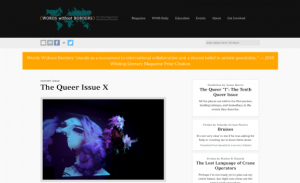Theme: Literature
Back to Top
|
 |
|
Words Without Borders
|
Language Arts |
|
Founded in 2003, the award-winning online magazine Words Without Borders (WWB) offers readers a terrific view into contemporary international literature. This resource aims to "open doors for readers of English around the world to the multiplicity of viewpoints, richness of experience, and literary perspective on world events offered by writers in other languages." WWB's monthly magazine publishes contemporary global fiction, non-fiction, and poetry translated into English, as well as reviews of newly translated works. Recent issue themes include WWB's tenth annual Queer issue (featuring new Korean Queer writing), explorations of identity from five Omani writers, new Swedish-language writing, and international graphic novels. Readers may also want to check out the magazine's Find & Search feature, which allows users to filter their entire catalog of articles by country, language, or keyword, among other fields. As of this write-up, WWB has published work by more than 2,200 authors, translated from 114 languages and representing 134 countries. In addition to WWB's magazine, their blog, WWB Daily, "offers commentary, interviews, and essays on timely topics related to translation and international literature." [JDC] |
|





|
|
 |
|
Reading Women
|
Language Arts |
|
Book lovers looking for a new literary podcast to enjoy may be interested in Reading Women, a show that "reclaims half the bookshelf by interviewing authors and reviewing books by or about women of all backgrounds and experiences." Launched in 2016, Reading Women is hosted by Kendra Winchester and Autumn Privett, who bonded over their "shared love for feminist literature" while in graduate school together. Their podcast, which releases new episodes every Wednesday, features thoughtful conversations about both fiction and nonfiction books, alternating every other week with interviews of women writers such as Soraya Chemaly and Anissa Gray. Each month's book conversations center on a theme, with one episode highlighting a number of titles on that theme and one featuring a more in-depth discussion about two of those titles. Examples of recent themes include "Working Class Stories" (June 2019) and "Australia and Surrounding Archipelago" (March 2019). Episodes of Reading Women are generally about 30-40 minutes long, and all episodes, as well as show notes and transcripts, are available at the link above. Listeners can also subscribe via Stitcher, Spotify, or other podcast platforms. [JDC] |
|





|
|
 |
|
PBS LearningMedia: Great American Read
|
Language Arts |
|
English literature teachers at many levels, as well as fans of classic literature, may be interested in this collection of educational resources from PBS LearningMedia created to accompany the 2018 PBS series The Great American Read. The collection is organized into three categories (elementary, middle, and high school), each containing resources related to titles that are often read at the indicated grade levels. Most of the featured titles are in the high school category, where readers will find classics such as The Great Gatsby and Pride and Prejudice, as well as contemporary selections like The Martian and The Hunger Games. Examples from the middle school section include The Outsiders and Little Women, while the elementary category highlights favorites like Charlotte's Web. Visitors to this collection will find video clips from The Great American Read, lesson plans, links to educational websites, and other resources, all chosen to help "contextualize the authors and the impact these books have had on specific readers and throughout history." [JDC] |
|





|
|
 |
|
Alluvium
|
Language Arts |
|
Readers with an interest in contemporary literature and literary criticism may appreciate Alluvium, which describes itself as "an open access scholarly journal dedicated to 21st-century writing as well as 21st-century approaches to the literary canon." Here, visitors will find a robust collection of peer-reviewed essays (with most accompanied by multiple images) on a wide range of timely contemporary literary themes and topics. For example, the most recent issue, published in July 2019, discusses prose and poetry centered on the theme of ecocriticism, while earlier essays explored contemporary speculative fiction, the relationship between print and digital literature, and much more. This electronic journal was originally founded in 2012 and relaunched in early 2019 as a graduate-run partner journal of the British Association of Contemporary Literary Studies. Alluvium is supported by the Department of English and Humanities at Birkbeck, University of London, and edited by a team of literary scholars around the U.K. The journal is published under Creative Commons Attribution 3.0 license and archived in the British Library's ISSN electronic store. [JDC] |
|





|
|
 |
|












